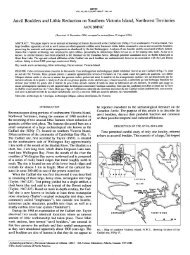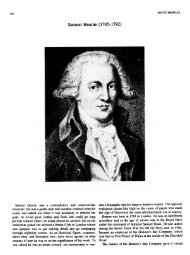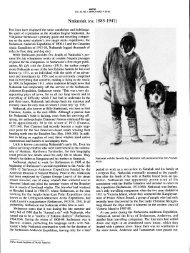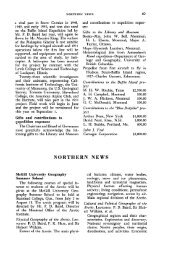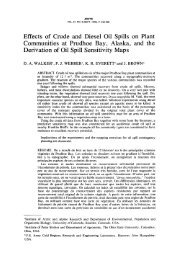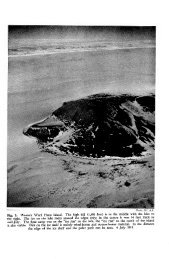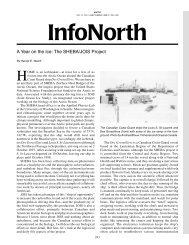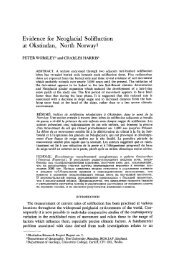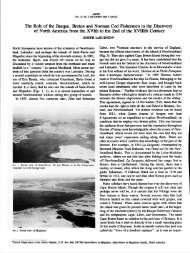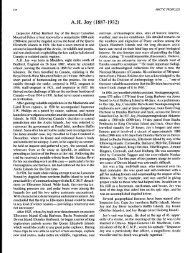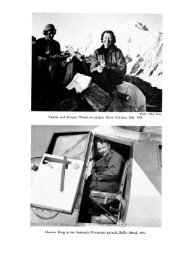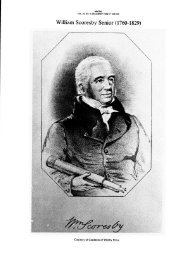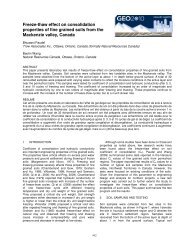Jens Munk (1579- 1628) - University of Calgary
Jens Munk (1579- 1628) - University of Calgary
Jens Munk (1579- 1628) - University of Calgary
Create successful ePaper yourself
Turn your PDF publications into a flip-book with our unique Google optimized e-Paper software.
246 ARCTIC PROFILES<br />
On the 4th <strong>of</strong> June 1620 <strong>Jens</strong> <strong>Munk</strong> must have surveyed a<br />
dismal scene surrounding him in <strong>Munk</strong>’s Harbour, a place<br />
now more familiar as Churchill. On that day he penned his last<br />
will and testament, giving little thought to any idea <strong>of</strong> ever getting<br />
back to Denmark, which, after the grim winter on this forbidden<br />
coast, must have seemed far away indeed. A decade<br />
earlier, Henry Hudson’s mutinous crew had set him adrift in<br />
the same bay that now trapped <strong>Munk</strong>, a bay that received more<br />
than Hudson’s name. To <strong>Munk</strong>, this must have seemed his<br />
own final voyage as well.<br />
<strong>Munk</strong>’s life can best be described as a long series <strong>of</strong> determined<br />
but frustrating efforts to gain recognition and a<br />
legitimate place in the ranks <strong>of</strong> the Danish nobility. Born on 3<br />
June <strong>1579</strong> in southern Norway, <strong>Jens</strong> <strong>Munk</strong> and his brother<br />
Niels were sons <strong>of</strong> the Danish nobleman Erik <strong>Munk</strong> and Anna<br />
Bartholomaeidatter. If it were not enough that Erik’s family<br />
tree was already somewhat tainted, the fact that he and Anna<br />
were not <strong>of</strong>ficially married assured the children much misery<br />
and endless frustration, particularly <strong>Jens</strong>. In the Age <strong>of</strong> the<br />
Reformation, such behaviour was not easily forgiven, and illegitimacy<br />
was a cause for shame and ridicule for the two<br />
boys.<br />
As a child, <strong>Jens</strong> <strong>Munk</strong> spent much <strong>of</strong> his time near the docks<br />
watching the excitement <strong>of</strong> ships arriving from distant lands.<br />
Not surprisingly, he went to sea at the age <strong>of</strong> 13. In 1609, he<br />
set sail with his partner <strong>Jens</strong> Hvid for the ice-filled Barents Sea<br />
in search <strong>of</strong> fox and bear. The trip was a disaster, ending in the<br />
wreck <strong>of</strong> the ship and the near loss <strong>of</strong> all the men; however,<br />
the voyage proved <strong>Munk</strong>’s capacity to survive severe arctic<br />
conditions and to conquer seemingly impossible odds.<br />
In 1618 the Danish King Christian IV ordered <strong>Munk</strong> to<br />
ready a major expedition to embark for East India via Cape<br />
Horn. Tirelessly, <strong>Munk</strong> organized the ships, the men, the provisions,<br />
and the thousand details involved in such an undertaking.<br />
To his astonishment, however, the command was not to<br />
be his; it fell to a man <strong>of</strong> suitable nobility, Ove Giedde.<br />
<strong>Munk</strong>’s setback was compounded by the deaths <strong>of</strong> his brother<br />
Niels and good friend Jdrgen Daas. The future was bleak, but<br />
<strong>Munk</strong> was not easily discouraged. He approached the king<br />
with a plan to launch another expedition to the far east, this<br />
one to proceed through the assumed northwest passage. Perhaps<br />
somewhat guilty <strong>of</strong> his treatment <strong>of</strong> <strong>Munk</strong>, the king<br />
assented. <strong>Munk</strong> chose 61 men and two vessels, one the heavy<br />
mothership the Unicorn (Enhjoringen) and the other the light<br />
reconnaissance vessel the Lamprey (Lampren).<br />
The ships were towed out <strong>of</strong> the harbour in a dead calm on<br />
Sunday, 9 May 16 19. Soon after they were under way, a<br />
bizarre suicide by one <strong>of</strong> the crew cast a shadow over the<br />
voyage. Another death followed shortly. Then they were detained<br />
in Norway to repair the leaking Lamprey. Not until the<br />
end <strong>of</strong> May did they depart from Norway with three new men.<br />
They crossed the Atlantic and entered Frobisher Bay by mis-<br />
<strong>Jens</strong> <strong>Munk</strong> (1 579- <strong>1628</strong>)<br />
take, and when they finally found their way into Hudson<br />
Strait, they accidentally sailed deep into Ungava Bay before<br />
they got back on the true course. By the time they reached<br />
Hudson Bay on September 4th, signs <strong>of</strong> scurvy were already<br />
present in the men.<br />
A savage storm forced <strong>Munk</strong> to make a spectacular entry<br />
with the Unicorn into a protected bay on the west coast at the<br />
site <strong>of</strong> present-day Churchill. The Lamprey soon followed,<br />
and the place was named Nova Dania. A wintering was clearly<br />
in store for the expedition, and little time was wasted in getting<br />
the ships to safe locations. The sheltered bay was a broad river<br />
mouth with extensive tidal flats. The Lamprey was hauled out<br />
<strong>of</strong> tidal reach and the Unicorn secured and used as winter<br />
quarters for both crews. Aware <strong>of</strong> the dangers <strong>of</strong> scurvy,<br />
<strong>Munk</strong> encouraged his men to eat berries and roots as long as<br />
possible, and the ravages <strong>of</strong> the dread disease were postponed<br />
for a while. Nevertheless, on the 21st <strong>of</strong> November one man<br />
died <strong>of</strong> scurvy, and another followed soon after.<br />
Christmas was made as festive as possible, and for a few<br />
days the reality <strong>of</strong> the harsh and increasingly cold environment<br />
was held at bay. Yet for all but three <strong>of</strong> the crew, this was to be<br />
their last Christmas. With the arrival <strong>of</strong> the new year - 1620<br />
- death began to stalk the ship regularly. One by one the men<br />
were buried on a nearby hill, but when May arrived no one had<br />
the strength to carry the dead <strong>of</strong>f the ship. Only seven men<br />
were alive when <strong>Jens</strong> <strong>Munk</strong> sat down to write his last will and<br />
testament, and a few days later he and the ship’s dog were the<br />
only living members on board. From the deck he was much<br />
surprised to see two crew members on shore and still alive;<br />
they had been unable to return to the ship several weeks<br />
earlier. Together, the three men began the slow road to recovery<br />
as spring prepared the land for summer.<br />
In order to escape, a formidable task awaited them. The<br />
Lamprey provided the only hope for a return voyage, and it<br />
had to be hauled into the sea and rigged for a crew <strong>of</strong> 3 instead<br />
<strong>of</strong> 16. On July 16 <strong>Munk</strong> began another, perhaps the greatest,<br />
epic journey. One can only imagine the next 67 days in iceinfested<br />
and storm-swept seas, across Hudson Bay, through<br />
the Strait, round the southern tip <strong>of</strong> Greenland, and forever<br />
eastward. The master mariner got the ship through it all, and<br />
on the 20th <strong>of</strong> September he spotted the distant mountains on<br />
the west coast <strong>of</strong> Norway.<br />
No hero’s welcome awaited <strong>Jens</strong> <strong>Munk</strong>. One <strong>of</strong> his men was<br />
involved in a tavern brawl, and as the captain responsible for<br />
his men, <strong>Munk</strong> was jailed; the revenge <strong>of</strong> the nobility was<br />
never far away. Apparently, the king was in no hurry to see<br />
<strong>Munk</strong> released, but he finally ordered his release after three<br />
months’ imprisonment.<br />
The king was not finished with <strong>Munk</strong>, however, and ordered<br />
him to prepare for a second expedition to Nova Dania, this<br />
time to colonize the region. The plan came to naught when no<br />
volunteers could be found, and <strong>Munk</strong> was undoubtedly re-
ARCTIC PROFILES 241<br />
<strong>Munk</strong>’s mothership, the Unicorn, would have been similar to the heavy three-masted vessel illustrated here. (From <strong>Jens</strong> <strong>Munk</strong> by Thorkild Hansen.)<br />
lieved. The expansionist king was not.doing.wel1, battles were<br />
being lost, and at the battle and defeat.at Kiel in the spring <strong>of</strong><br />
<strong>1628</strong>, <strong>Jens</strong> <strong>Munk</strong> seems to have been.wounded. He returned to<br />
Copenhagen, where his new young wife cared for him until his<br />
death a few months later.<br />
<strong>Jens</strong> <strong>Munk</strong> had lived a remarkable life. In Canada, however,<br />
only one small island in Fox Basin bears his name. <strong>Munk</strong> himself<br />
never saw <strong>Jens</strong> <strong>Munk</strong> Island, but members <strong>of</strong> the Danish<br />
Fifth Thule Expedition thought it appropriate to leave one<br />
small reminder <strong>of</strong> his brief presence in this part <strong>of</strong> the world<br />
that had become - not Nova Dania - but Canada.<br />
FURTHER READINGS<br />
BIRKET-SMITH, KM. 1929. <strong>Jens</strong> <strong>Munk</strong>s Rejse 0% andre danske Ishavsfarter<br />
under Christian IV. Copenhagen.<br />
GOSCH, C.C.A. 1897. Danish Arctic Expeditions 1605-20. Vol 1-11. London:<br />
Hakluyt Society.<br />
HANSEN, THORKILD. 1966. <strong>Jens</strong> <strong>Munk</strong>; Copenhagen: Gyldendal.<br />
KNUDSEN, JOHANNES. 1902. Den danske Ishavsfarer <strong>Jens</strong> <strong>Munk</strong>. Copenhagen.<br />
MUNK, JENS. 1723. Navigatio Septentrionalis. Heri: Capitain <strong>Jens</strong> <strong>Munk</strong>s<br />
Livs oghvnets beskrivelse. Til stdrste deels af Hans egenhaendige Jourder<br />
og Resten af andre Trovaerdige Documenter uddragen. Copenhagen.<br />
Peter Schledermann<br />
The Arctic Institute <strong>of</strong> North America<br />
<strong>University</strong> <strong>of</strong> <strong>Calgary</strong><br />
<strong>Calgary</strong>, Alberta, Canada<br />
T2N IN4



